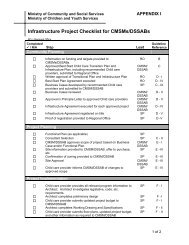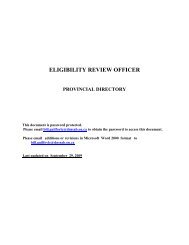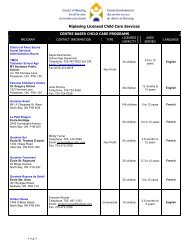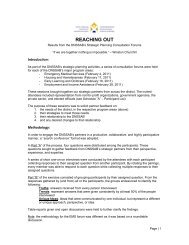- Page 1 and 2: 800 Housing Starts & Completions (#
- Page 3 and 4: ACKNOWLEDGEMENTS This study involve
- Page 5 and 6: 3) Purpose This study is being unde
- Page 7 and 8: All of Nipissing’s municipalities
- Page 9 and 10: TABLE OF CONTENTS KEY FINDINGS . .
- Page 11 and 12: TABLE OF CONTENTS 14.0 Supportive &
- Page 13 and 14: LIST OF FIGURES Figure Page Section
- Page 15 and 16: LIST OF FIGURES Figure Page 81 Aver
- Page 17 and 18: LIST OF TABLES Table Page Section V
- Page 19 and 20: KEY FINDINGS The following key find
- Page 21 and 22: The Districts urban areas (Mattawa
- Page 23 and 24: KEY FINDINGS Nipissing District’
- Page 25: KEY FINDINGS In family terms, the
- Page 29 and 30: KEY FINDINGS • The decrease in av
- Page 31 and 32: KEY FINDINGS It can be noted fro
- Page 33 and 34: 10-YEAR POPULATION & HOUSEHOLD FORE
- Page 35 and 36: 10-YEAR POPULATION & HOUSEHOLD FORE
- Page 37 and 38: • Based on 2006 household incomes
- Page 39 and 40: RECOMMENDATIONS The following are t
- Page 41 and 42: # RECOMMENDATION BACKGROUND LEAD 10
- Page 43 and 44: The construction of Toronto’s Reg
- Page 45 and 46: 1.1 Social Housing Devolution Accom
- Page 47 and 48: SECTION II: NIPISSING’S KEY HOUSI
- Page 49 and 50: Figure 4: Income Distribution, Nipi
- Page 51 and 52: Figure 8: Housing Starts & Completi
- Page 53 and 54: Figure 12: Housing Roles & Responsi
- Page 55 and 56: Nipissing District is not exempt -
- Page 57 and 58: Likewise, jumps along the continuum
- Page 59 and 60: On the supply side as rental prices
- Page 61 and 62: At the District level, affordable h
- Page 63 and 64: ii) Affordable housing for the Abor
- Page 65 and 66: As the map above indicates, Nipissi
- Page 67 and 68: West Nipissing is the next largest
- Page 69 and 70: The District’s population peak in
- Page 71 and 72: Of particular significance is the i
- Page 73 and 74: The 3.5% increase in the number of
- Page 75 and 76: One of the main questions facing th
- Page 77 and 78:
By 1998, migration was still negati
- Page 79 and 80:
The municipalities are presented in
- Page 81 and 82:
During the 15-year period of declin
- Page 83 and 84:
The population of East Ferris has d
- Page 85 and 86:
Perhaps most significant for Bonfie
- Page 87 and 88:
As indicated by the dotted line on
- Page 89 and 90:
Below is a comparative summary of t
- Page 91 and 92:
In the past 20 years, Mattawa’s s
- Page 93 and 94:
As noted on the following chart, th
- Page 95 and 96:
Additionally, Chisholm has one of t
- Page 97 and 98:
The 20% increase in senior citizens
- Page 99 and 100:
Below is a comparative summary of t
- Page 101 and 102:
After steady growth in the children
- Page 103 and 104:
ii) Aboriginal Groups: Nipissing Di
- Page 105 and 106:
X) Unorganized Areas: Nipissing Nor
- Page 107 and 108:
The steady growth in households is
- Page 109 and 110:
5.3 Household & Family Types: Nipis
- Page 111 and 112:
5.3 vi) Multiple- family households
- Page 113 and 114:
General household incomes for rente
- Page 115 and 116:
These profiles are for households i
- Page 117 and 118:
Although they comprise just 11% of
- Page 119 and 120:
5.4 iv) Rental-supply implications
- Page 121 and 122:
Regarding the apartments that owner
- Page 123 and 124:
The number of Nipissing’s househo
- Page 125 and 126:
5.6 i) Period of Construction The t
- Page 127 and 128:
In 2006, there were 3,415 household
- Page 129 and 130:
In comparing the types of housing t
- Page 131 and 132:
• Public housing and Urban Native
- Page 133 and 134:
6.0 Household Trends: Nipissing’s
- Page 135 and 136:
It can be noted from the above tabl
- Page 137 and 138:
The chart above shows the percentag
- Page 139 and 140:
Notes: 1) The geographical changes
- Page 141 and 142:
6.3.2, i) Single Households As seen
- Page 143 and 144:
6.4.3) Bonfield, East Ferris and Te
- Page 145 and 146:
6.4.2) North Bay Homeownership Leve
- Page 147 and 148:
• During the past 20 years, the p
- Page 149 and 150:
For West Nipissing renters, the mos
- Page 151 and 152:
The clear anomaly in the above char
- Page 153 and 154:
Figure 60: Population Projections:
- Page 155 and 156:
Figure 62: Population Projections,
- Page 157 and 158:
The following table displays these
- Page 159 and 160:
The table reveals that a large perc
- Page 161 and 162:
• $20,000 - $29,000: approximatel
- Page 163 and 164:
8.0 Population and Household Foreca
- Page 165 and 166:
In the present low- vacancy environ
- Page 167 and 168:
Table 36: Average Tenure by Headshi
- Page 169 and 170:
In terms of real growth, the $20K -
- Page 171 and 172:
During information sessions, they i
- Page 173 and 174:
The above table also shows that the
- Page 175 and 176:
SECTION VI: SOCIOECONOMIC CHARACTER
- Page 177 and 178:
• The local health region has a g
- Page 179 and 180:
Income Figure 66: Individual Income
- Page 181 and 182:
Figure 70: Lowest Level of Schoolin
- Page 183 and 184:
This is in keeping with one of the
- Page 185 and 186:
T he above table pro vides insight
- Page 187 and 188:
• Three of the above shelters do
- Page 189 and 190:
• Violence Against Women (VAW) is
- Page 191 and 192:
The following table lists the suppo
- Page 193 and 194:
Some of the points refer to systemi
- Page 195 and 196:
It does include PHARA however, whic
- Page 197 and 198:
Table 48: Summary Results from Hous
- Page 199 and 200:
It can be noted that since Jan. 200
- Page 201 and 202:
There are broad affordability indic
- Page 203 and 204:
The other notable observation from
- Page 205 and 206:
Table 51: Housing Affordability Gap
- Page 207 and 208:
t The above indicates that there ar
- Page 209 and 210:
16.4) Information Session with Priv
- Page 211 and 212:
It can be noted that Nipissing’s
- Page 213 and 214:
The above chart is for the period S
- Page 215 and 216:
$180 sq. ft. • It can cost $40-$5
- Page 217 and 218:
Figure 87: Gaps along t he Nipissin
- Page 219 and 220:
18.2 Long-term Care (LTC) Facilitie
- Page 221 and 222:
- Renting a room in someone else’
- Page 223 and 224:
- This group of students has a larg
- Page 225 and 226:
Present Housing Arrangements - Appr
- Page 227 and 228:
- Another 23.5% of the employees pa
- Page 229 and 230:
19.3 Social Assistance Recipients S
- Page 231 and 232:
- For those who pay their rent & ut
- Page 233 and 234:
Seniors Present Housing Arrangement
- Page 235 and 236:
- In terms of requiring community h
- Page 237 and 238:
20.0 Canada-Ontario Affordable Hous
- Page 239 and 240:
Complete and Occupied Location: Cou
- Page 241 and 242:
The roles as defined in the second
- Page 243 and 244:
Earlier in the report it was noted
- Page 245 and 246:
In view of the information containe
- Page 247 and 248:
The overlapping circles in the abov
- Page 249 and 250:
26.2 Housing and Education Intuitiv
- Page 251 and 252:
Trying to grow a workforce with a l
- Page 253 and 254:
SECTION XI: BEST HOUSING PRACTICES
- Page 255 and 256:
27.3 Residential Intensification an
- Page 257 and 258:
This document provides a framework
- Page 259 and 260:
SECTION XII: MOVING FORWARD There a
- Page 261 and 262:
LIST OF ACRONYMS CA: Census Agglome
- Page 263 and 264:
Examples are shelters, lodging or r
- Page 265 and 266:
Long - Term Care (LTC) Long - Term
- Page 267 and 268:
Socioeconomic: Strong Communities S
- Page 269 and 270:
Bibliography Assembly of First Nati
- Page 271 and 272:
SHS Inc. (Social Housing Strategist
- Page 273 and 274:
The greater the difference between
- Page 275 and 276:
Additionally, population estimates
- Page 277 and 278:
Municipality /Area 1986 1991 1996 2
- Page 279 and 280:
) West Nipissing and Mattawa: House
- Page 281 and 282:
3.3) Household Type, 1986- 2006 Not
- Page 283 and 284:
Household Types: Airy /South Algonq
- Page 285 and 286:
East Nipissing Planning Area: House
- Page 287 and 288:
3.5) Households by Structural Type,
- Page 289 and 290:
Households by Structural Type: Airy
- Page 291 and 292:
Number of Dwellings by Period of Co
- Page 293 and 294:
Registry Wait List By Month/Area/Fa
- Page 295 and 296:
North Bay, Top 25 Employers (based
- Page 297 and 298:
Report prepared for the Ontario Pro
- Page 299 and 300:
d. Supply of Residential Lots and/o
- Page 301 and 302:
8. LAND USE DEVELOPMENT a. General
- Page 303 and 304:
c. Household Average Size: d. Suppl
- Page 305 and 306:
j. Accessory Apartments: West Nipis
- Page 307:
12. PERFORMANCE MEASURES a. Monitor








